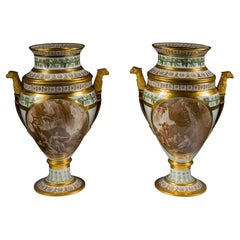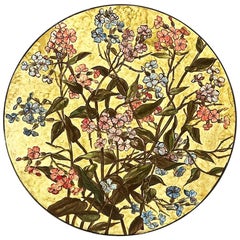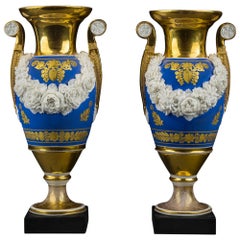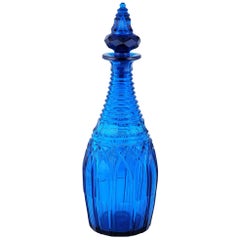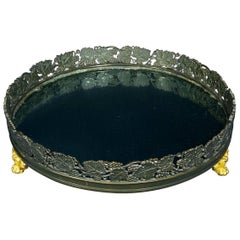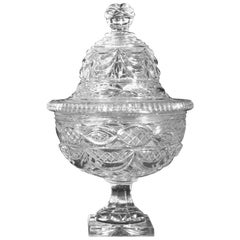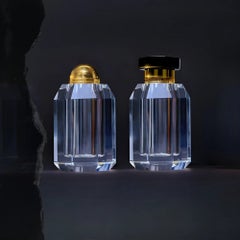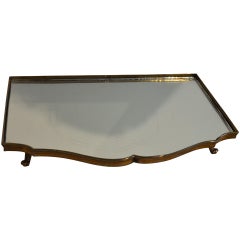Hirschl & Adler Serveware, Ceramics, Silver and Glass
to
7
7
5
1
4
3
3
1
1
7
6
4
1
1
1
7
7
7
1
1
Pair of Porcelain Urn Form Fruit Coolers with Covers and Liners
By Stône, Coquerel, and Legros d'Anisy
Located in New York, NY
Pair Footed Fruit Coolers, about 1810-20
Stône, Coquerel, and Legros D’Anisy, Paris (active 1808–49)
Porcelain, partially transfer printed in sepia and green and gilded
Each, 13 1/2 in. high x 10 in. wide x 7 1/2 in. deep
Signed and inscribed (on underside of one top and one base, with printed mark): STÔNE /
COQUEREL / ET / LE GROS / PARIS / PAR BREVET D’INVENTION: Manufre de Décors sur
Porcelaine Faience; variously inscribed with decorators’ initial in green and brown (on
underside of one top and one base): M; variously inscribed with incised mark (on underside of one liner and both bottoms): 3; inscribed (in blue script, on the inside of one liner): 615
The Parisian firm of Stône, Coquerel, and Legros d'Anisy is distinguished for the important role that it played in the introduction of transfer-printed decoration on fine china in France. Although the process had been known and used in Great Britain since the eighteenth century, it was, according to Régine de Plinval de Guillebon in her book, Porcelain of Paris 1770–1850 (New York: Walker and Company, 1972), not until 1802 that Potter, Blancheron, Constant, Neppel, Cadet de Vaux & Denuelle took out a patent in France for transfer-printing on earthenware, and it was only on February 26, 1808, that John Hurford Stône, his brother-in-law, Athanase Marie Martin Coquerel, and Francois Antoine Legros d'Anisy not only took out a patent for transfer-printing on china, but also established a Stône, Coquerel, and d'Anisy partnership for the manufacture of transfer-printed ceramics. Their address from 1808 until 1818 was at 9, rue de Cadran, Paris.
Prior to this, Stône and Coquerel had been partners at a creamware factory in Creil, France, and Legros d’Anisy had worked at the Sèvres factory, where he had apparently developed the transfer-printing technique for which his own firm became well known. “The process,” notes de Guillebon, was “based upon removing from the engraving a ‘pull’ made on a specially coated filter-paper, which was pressed onto the object to be decorated; this object itself was covered with a film. Firing took...
Category
Antique Early 19th Century French Neoclassical Wine Coolers
Materials
Porcelain
Earthenware John Bennett Plaque with Pink and Blue Phlox
By John Bennett
Located in New York, NY
FAPG 20247D
John Bennett (1840-1907), New York
Plaque with pink and blue phlox, circa 1881-1882
Earthenware, painted and glazed
Measures: 14 7/8 in. diameter, 1 13/16 in. high
Signed and inscribed (on the back): J B[monogram] ENNETT /
E 24 NY. / MC [or] CM
If the Herter Brothers was the most distinguished and successful cabinet making and decorating firm in New York in the 1870s-1880s, the transplanted Englishman John Bennett was probably the most gifted ceramicist working in New York in the Aesthetic period. (Bennett was included in The Metropolitan Museum of Art’s landmark exhibition, In pursuit of beauty: Americans and the Aesthetic Movement, in 1986–87, and Alice Cooney Frelinghuysen’s chapter, “Aesthetic Forms in Ceramics and Glass,” pp. 216–19, significantly informs this essay). Born in England, the son of a potter who worked in the Staffordshire district, Bennett came under the influence of John Sparkes, head of London’s Lambeth School of Art. Soon thereafter, he was hired by Henry Doulton of the eponymous firm to teach artisans there the new art of underglaze faience decoration, which was part of a revival of the sixteenth-century interest in hand-painted ceramics.
A number of Bennett’s works for Doulton were shown in the Doulton display at the Centennial Exposition in Philadelphia in 1876, and the considerable success enjoyed by Bennett and Doulton from an American audience undoubtedly played an important role in Bennett’s decision to leave Doulton and England and set up shop in New York in 1877. By the next year, he had already established a studio in New York, where he produced his own pottery in the tradition of the Arts & Crafts innovators, William Morris and William De Morgan, and also taught classes at the new Society of Decorative Art to the growing band of women who had taken up china painting, both professionally and avocationally.
Bennett’s pottery developed a very serious following among students and collectors, and was offered for sale at such leading retail establishments as Tiffany & Company in New York. Typically, his work was brilliantly colored, with carefully drawn naturalistic flowers against a monochromatic background.
Bennett’s fully developed American work, particularly pieces of larger scale, is exceedingly rare, as he worked in New York only from 1877 to 1883, in which year he withdrew to a farm in rural West Orange, New Jersey, where his production continued on a limited basis. He remained listed as a ceramicist there until 1889. While in New York City, Bennett maintained a studio at 412 East 24th Street. The present charger, boldly featuring pink and blue phlox, is signed by Bennett, and is inscribed “E 24 NY,” indicating its manufacture during Bennett’s time in New York. Although it is not dated, this piece is closely related stylistically to various dated pieces from 1881–82, which would place its production toward the end of Bennett’s New York years.
Although we do not know whether Bennett worked out of this 24th Street studio from the outset, he was indeed working there by 1879 when he made (and signed, inscribed, and dated) a charger with white and red flowers now in the collection of the Art Institute of Chicago, which specifically points to “412 East 24 / NY” (acc. no. 1998.317). Additionally, the U.S. Census of 1880 lists Bennett as a ceramicist located at that same address, married to Mary Bennett with whom he had had six children. There are several other examples from Bennett’s time in New York City, which also give his studio address on East 24th Street, including a covered jar in cadmium yellow with indigo and green flowers made in 1881; an undated footed vase with lilac...
Category
Antique 1880s American Aesthetic Movement Ceramics
Materials
Earthenware
Pair of "Old Paris" Vases with Garlands of Bisquit Flowers
Located in New York, NY
French, circa 1820.
Porcelain, painted and gilded, with applied bisquit flowers
8 13/16 in. high.
Inscribed (with incised mark, under the base of each): 3.
Category
Antique 1820s French Neoclassical Porcelain
Materials
Porcelain
Peacock Green Cut-Glass Decanter
Located in New York, NY
Peacock green cut-glass decanter
English, circa 1840.
Glass, blown and cut.
Measures: 13 1/2 in. high.
Condition: Perfect, except for minor flakes on the bottom of stopper.
Category
Antique 1840s English Neoclassical Glass
Materials
Glass
Plateau in the Restauration Taste with Grape and Leaf Motifs
Located in New York, NY
French.
Plateau in the Restauration taste with grape and leaf motifs, circa 1825.
Ormolu and patinated bronze, with mirror plate and wood backing.
Measures: 15 7/8 in. diameter, 3 11...
Category
Antique 1820s French Neoclassical Platters and Serveware
Materials
Bronze
Monumental Clear Cut-Glass Covered Compote
Located in New York, NY
Monumental clear cut-glass covered compote, circa 1820.
La Cristallerie de Vonêche (active 1802-30), Belgium.
Glass, blown and cut.
Measures: 17 3/8 i...
Category
Antique Early 19th Century Belgian Neoclassical Tableware
Materials
Blown Glass, Cut Glass
Pair of Medici-Form Vases
Located in New York, NY
Attributed to Schoelcher, Paris, France, circa 1830.
Porcelain, painted and gilded.
16 1/4 in. high, 9 1/2 in. wide, 9 1/2 in. deep.
Ex Coll.: by repute, Joseph Bonaparte...
Category
Antique Mid-19th Century French Empire Porcelain
Materials
Porcelain
Related Items
Hand cut Crystal Saltshaker set Ambrosià (2-piece set: clear & clear)
Located in Glendale, CA
Ambrosià Crystal Salt & Pepper Shakers are exquisite tableware items designed to add a touch of elegance and sophistication to any dining experience. Crafted from high-quality gray crystal, these shakers are delicately shaped and designed with intricate patterns that catch the light beautifully. These functional salt and pepper shakers serve as stunning decorative elements and are perfect for special occasions, formal dinners, or as statement pieces for a stylish home. Each crystal Salt and Pepper Shaker...
Category
2010s Modern Tableware
Materials
Crystal
Early 19th Century Plateau Mirror
Located in Copenhagen, K
Plateau mirrors was used on the dining or dressing table, in front of guest of honor, to put flowers or candles on.
Category
Antique Early 19th Century French Empire Table Mirrors
Materials
Bronze
Try-Tray Small Square Tray in Clear Orange, Clear, Clear Yellow by Gaetano Pesce
By Corsi Design Factory, Gaetano Pesce
Located in barasso, IT
Try tray square - clear orange, clear, clear yellow
Tray in hard resin designed by Gaetano Pesce in 1998 for Fish Design collection.
Additional Info:
Material: Hard resin
Col...
Category
21st Century and Contemporary Italian Tableware
Materials
Resin
H 1.19 in W 8.27 in D 8.27 in
Travertine Vase and Wine Cooler
Located in Eindhoven, NB
Our wine cooler is designed by us and hand crafted by the artisans within the fair-trade principles.
Crafted from a natural travertine stone, this vessel will be sure to win your he...
Category
2010s Dutch Modern Wine Coolers
Materials
Travertine
Crystal Mix Set of 6 Cobalt Stem Glasses with Overlay Cut to Clear
By Nachtmann
Located in Verviers, BE
Vintage set of 6 cut to clear crystal stem glasses.
Mix crystal (Bleikristall 24% Mundgeblasen Handgeschliffen) glasses
Clear demi crystal glass. Side facetted and toothed stem.
Th...
Category
Vintage 1950s German Mid-Century Modern Crystal Serveware
Materials
Crystal
Earthenware Bowl with Interpretations of Traditional Creamware Forms
By Faye Toogood
Located in London, GB
Indigo Storm, 1882 Ltd. with Faye Toogood. Faye Toogood’s range of ceramic designs for 1882 Ltd. celebrates the accidental beauty of natural imperfec...
Category
21st Century and Contemporary British Modern Ceramics
Materials
Ceramic
English Late Spode Graduated Platters with Insert in the Chinese Imari Taste
By Copeland Spode
Located in San Francisco, CA
A beautiful 3 piece grouping of English Late Spode Chinese Imari pattern platters in graduated sizes, including a perforated insert strainer. The grouping is elaborately decorated ...
Category
Antique 1840s English Early Victorian Platters and Serveware
Materials
Gold
H 2 in W 20 in D 15.75 in
Antique Old Paris or Vieux Paris Porcelain Fan Shaped Vase
By Old Paris, Manufacture Le Vieux Paris
Located in Philadelphia, PA
A fine antique French porcelain vase.
With extensive gilding and painted floral decoration to each side.
Simply a great piece of Ol...
Category
Antique 19th Century French Belle Époque Vases
Materials
Porcelain
Hand cut Crystal Saltshakers Ambrosià (salt-pepper shaker set: clear & golden)
Located in Glendale, CA
Ambrosià Crystal Salt & Pepper Shakers are exquisite tableware items designed to add a touch of elegance and sophistication to any dining experience. Crafted from high-quality gray crystal, these shakers are delicately shaped and designed with intricate patterns that catch the light beautifully. These functional salt and pepper shakers serve as stunning decorative elements and are perfect for special occasions, formal dinners, or as statement pieces for a stylish home. Each crystal Salt and Pepper Shaker...
Category
2010s Modern Tableware
Materials
Crystal
H 3.5 in W 2.2 in D 3.5 in
Pair of Meissen Porcelain Vases with Snake Handles
By Meissen Porcelain
Located in Pembroke, MA
A highly-decorative pair of yellow porcelain vases, hand-painted with detailed central romantic scene, and having snake-form handles (Me...
Category
Antique Late 19th Century French Neoclassical Vases
Materials
Porcelain
18th Century Rococo German Painted and Gilt Wine Cooler in the Form of a Swan
Located in Troy, NY
Extraordinary wine-cooler in the form of a beautifully sculpted, gilt and polychromed Swan of impressive stature, makes certainly the conversation-piece of the party. The white paint...
Category
Antique 18th Century German Rococo Wine Coolers
Materials
Tin
H 35 in W 32 in D 17.5 in
Earthenware Pasta Bowl with Interpretations of Traditional Creamware
By Faye Toogood
Located in London, GB
Indigo Storm, 1882 Ltd. with Faye Toogood. Faye Toogood’s range of ceramic designs for 1882 Ltd. celebrates the accidental beauty of natural imperfec...
Category
21st Century and Contemporary British Modern Ceramics
Materials
Ceramic
